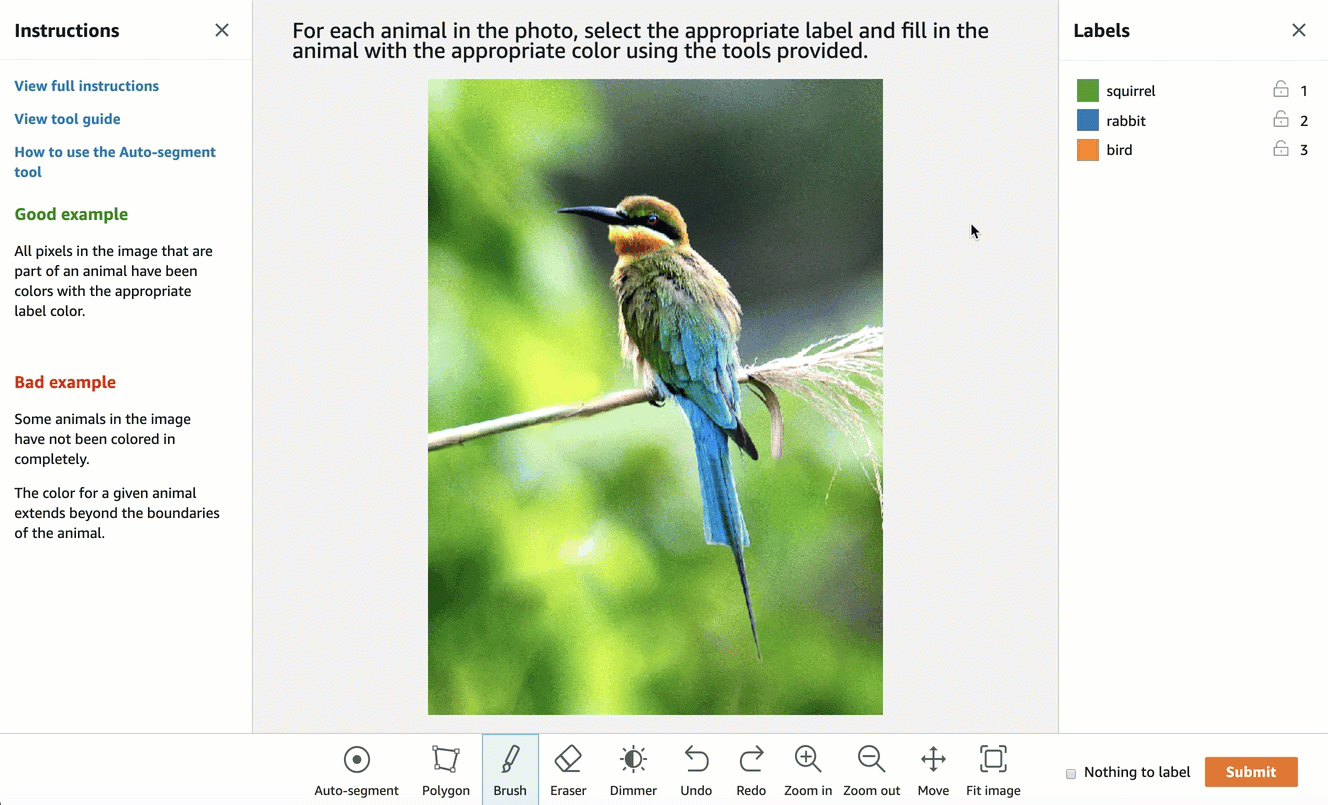Identify image contents using semantic segmentation
To identify the contents of an image at the pixel level, use an Amazon SageMaker Ground Truth semantic
segmentation labeling task. When assigned a semantic segmentation labeling job, workers
classify pixels in the image into a set of predefined labels or classes. Ground Truth supports
single and multi-class semantic segmentation labeling jobs. You create a semantic
segmentation labeling job using the Ground Truth section of the Amazon SageMaker AI console or the CreateLabelingJob operation.
Important
For this task type, if you create your own manifest file, use
"source-ref" to identify the location of each image file in Amazon S3 that
you want labeled. For more information, see Input data.
Creating a Semantic Segmentation Labeling Job (Console)
You can follow the instructions Create a Labeling Job (Console) to learn how to create a semantic segmentation labeling job in the SageMaker AI console. In Step 10, choose Image from the Task category drop down menu, and choose Semantic segmentation as the task type.
Ground Truth provides a worker UI similar to the following for labeling tasks. When you create the labeling job with the console, you specify instructions to help workers complete the job and labels that workers can choose from.

Create a Semantic Segmentation Labeling Job (API)
To create a semantic segmentation labeling job, use the SageMaker API operation
CreateLabelingJob. This API defines this operation for all Amazon SDKs.
To see a list of language-specific SDKs supported for this operation, review the
See Also section of CreateLabelingJob.
Follow the instructions on Create a Labeling Job (API) and do the following while you configure your request:
-
Pre-annotation Lambda functions for this task type end with
PRE-SemanticSegmentation. To find the pre-annotation Lambda ARN for your Region, see PreHumanTaskLambdaArn . -
Annotation-consolidation Lambda functions for this task type end with
ACS-SemanticSegmentation. To find the annotation-consolidation Lambda ARN for your Region, see AnnotationConsolidationLambdaArn.
The following is an example of an Amazon Python SDK (Boto3) request
response = client.create_labeling_job( LabelingJobName='example-semantic-segmentation-labeling-job, LabelAttributeName='label', InputConfig={ 'DataSource': { 'S3DataSource': { 'ManifestS3Uri':'s3://bucket/path/manifest-with-input-data.json'} }, 'DataAttributes': { 'ContentClassifiers': ['FreeOfPersonallyIdentifiableInformation'|'FreeOfAdultContent', ] } }, OutputConfig={ 'S3OutputPath':'s3://bucket/path/file-to-store-output-data', 'KmsKeyId':'string'}, RoleArn='arn:aws:iam::*:role/*, LabelCategoryConfigS3Uri='s3://bucket/path/label-categories.json', StoppingConditions={ 'MaxHumanLabeledObjectCount':123, 'MaxPercentageOfInputDatasetLabeled':123}, HumanTaskConfig={ 'WorkteamArn':'arn:aws:sagemaker:region:*:workteam/private-crowd/*', 'UiConfig': { 'UiTemplateS3Uri':'s3://bucket/path/worker-task-template.html'}, 'PreHumanTaskLambdaArn': 'arn:aws:lambda:us-east-1:432418664414:function:PRE-SemanticSegmentation, 'TaskKeywords': ['Semantic Segmentation', ], 'TaskTitle':'Semantic segmentation task', 'TaskDescription':'For each category provided, segment out each relevant object using the color associated with that category', 'NumberOfHumanWorkersPerDataObject':123, 'TaskTimeLimitInSeconds':123, 'TaskAvailabilityLifetimeInSeconds':123, 'MaxConcurrentTaskCount':123, 'AnnotationConsolidationConfig': { 'AnnotationConsolidationLambdaArn': 'arn:aws:lambda:us-east-1:432418664414:function:ACS-SemanticSegmentation' }, Tags=[ { 'Key':'string', 'Value':'string'}, ] )
Provide a Template for Semantic Segmentation Labeling Jobs
If you create a labeling job using the API, you must supply a worker task template
in UiTemplateS3Uri. Copy and modify the following template. Only modify
the short-instructions, full-instructions, and header.
Upload this template to S3, and provide the S3 URI for this file in
UiTemplateS3Uri.
Semantic Segmentation Output Data
Once you have created a semantic segmentation labeling job, your output data will be
located in the Amazon S3 bucket specified in the S3OutputPath parameter when
using the API or in the Output dataset location field of the
Job overview section of the console.
To learn more about the output manifest file generated by Ground Truth and the file structure the Ground Truth uses to store your output data, see Labeling job output data.
To see an example of an output manifest file for a semantic segmentation labeling job, see 3D point cloud semantic segmentation output.